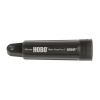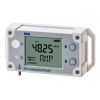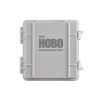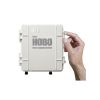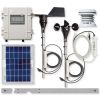HOBO Split-Core Bi-Polar DC Transducer Sensor
Features
- Adjustable span range
- Small size, split-core for ease of installation
- Expedited repair and warranty service
- Lifetime technical support
- More
Overview
The Onset split-core bi-polar DC transducer sensor measures up to 200 Amps of DC current in both flow directions.
Requirements (Logger Specific):
- HOBO MX1100 series: a 4-20mA input cable (SD-MA-420) and external power provided by an AC adapter (AC-SENS-1)
- HOBO UX120-006M or ZW series: a 4-20mA input cable (CABLE-4-20mA) and external power provided by an AC adapter (AC-SENS-1)
- HOBO RX3000: an analog input module (RXMOD-A1)
- HOBO U30: an analog input module (VIA)
- HOBO H22: an analog input module (S-FS-CVIA)
- DC Amperage: (bi-polar)
- Measurement range: +/- 2 to +/- 200 (via span adjust)
- Accuracy (below 100A span): +/- .5 A
- Accuracy (above 100A span): +/- .5% full scale
- Sensor supply: 12 - 24 DC (15 VDC min. for currents > 120 A), 35 mA no-load to 110 mA at 200 A current
- Isolation: 600 VAC rms
- Operating temperature range: -30 to 60C (-22 to 140F)
- Humidity range: 10 - 90% non-condensing
- Response time: 2 sec.
- Output: (bi-polar) 4 - 20mA
- Dimensions: 3.1x2.8x1.4 in. (79x70x36 mm)
- Weight: 5.25 oz.
- Sensor opening: 1.1x.9 in. (28x23 mm)
- LED indications: single green blink=Norm, double green=Over Span, red+green=Over Limit, solid red=overload
In The News
Long-Term Monitoring in the Chautauqua Lake Watershed
With a widely developed shoreline, Chautauqua Lake experiences influxes of non-point source pollution that have historically impacted the health of the lake. The Chautauqua Lake Association (CLA) has been monitoring the lake for over two decades, reporting on changes that have occurred over the years. A pair of local lake advocates, Jane and Doug Conroe, have lived on the lake for over 40 years and have played an important role in establishing monitoring programs and facilitating consistent data collection throughout the watershed. Doug has been involved with the Chautauqua Lake Association (CLA) since the pair moved to the area in 1980, and is currently serving as the Executive Director.
Read MoreNo Red Herrings: Data Driving the Largest Salt Marsh Restoration in the NE USA
The Herring River system encompasses around 1,000 acres in the Towns of Wellfleet and Truro, Massachusetts. In 1909, the Chequessett Neck Road dike was built at the river’s mouth, drastically limiting tidal flow. Today, it’s one of the most restricted estuaries in the northeastern United States. As a result, the area has suffered environmental decline, including poor water quality, hypoxia, lower pH, and salt marsh degradation. In 2023, the Town of Wellfleet received $14.7 million from NOAA’s Office of Habitat Conservation to fund the Herring River Restoration Project (HRRP). Francesco Peri, President and CEO at Charybdis Group LLC, uses a network of NexSens data loggers to monitor water level and water quality on the Herring River.
Read MoreCarbon and Nutrient Monitoring in the Great Lakes Using Satellite Observations
Carbon and nutrients are the foundation of lake food webs and play an important role in the chemical and physical processes that shape aquatic ecosystems and various lake dynamics. Studying these cornerstones can help improve understanding of other lake conditions like harmful algal blooms, hypoxia, and phytoplankton community composition. The way in which these characteristics are monitored varies, though many rely on a proxy approach wherein parameters are extrapolated from the measurement of a different parameter. An assistant professor at Cleveland State University, Brice Grunert, is working to improve current strategies and take a satellite approach to monitoring the Great Lakes.
Read More


